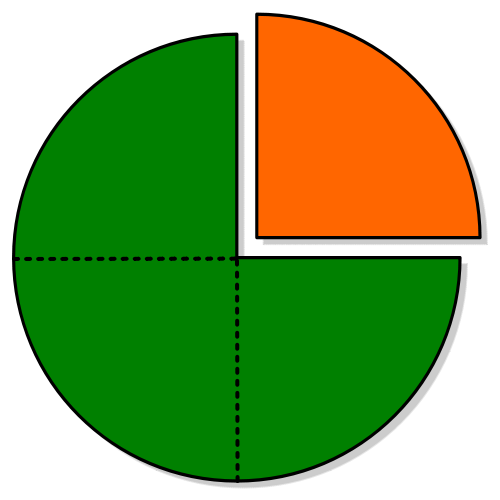Adding and Subtracting Fractions Lesson
Lesson Overview
- What Are Fractions?
- Adding Fractions with the Same Denominator
- Adding Fractions with Different Denominators
- Subtracting Fractions with the Same Denominator
- Subtracting Fractions with Different Denominators
- Improper Fractions and Mixed Numbers
- Simplifying Fractions
- Practice Problems
Fractions are an essential part of mathematics that allow us to represent parts of a whole. In real life, adding and subtracting fractions is a common task. Whether you're working with recipes, measurements, or even time, understanding how to add and subtract fractions is crucial.
This lesson will teach you how to handle fractions, starting with simple examples and moving to more complex problems. We will explore how to add and subtract fractions with the same and different denominators and learn how to simplify the results.
What Are Fractions?
A fraction represents a part of a whole. It consists of two parts:
- Numerator (top number): The number of parts you have.
- Denominator (bottom number): The total number of equal parts in the whole.
For example, 3/4 means you have 3 out of 4 equal parts of a whole.
Adding Fractions with the Same Denominator
Adding fractions is easy when they have the same denominator. In this case, you simply add the numerators and keep the denominator the same.
Example 1:
5/10 + 4/10 Both fractions have a denominator of 10, so you just add the numerators:
5 + 4 = 9
Therefore, the sum is 9/10.
Steps to Add Fractions with the Same Denominator:
- Add the numerators.
- Keep the denominator the same.
Take This Quiz:
Adding Fractions with Different Denominators
When adding fractions with different denominators, you need to find a common denominator before adding them. The least common denominator (LCD) is the smallest number that both denominators can divide into evenly.
Steps to Add Fractions with Different Denominators:
- Find the least common denominator.
- Convert each fraction to have the LCD as the denominator.
- Add the numerators.
- Simplify the fraction, if possible.
Example 2:
3/4 + 2/5 The least common denominator (LCD) of 4 and 5 is 20. Now, convert both fractions:
- 3/4 becomes 15/20 (multiply both the numerator and denominator by 5).
- 2/5 becomes 8/20 (multiply both the numerator and denominator by 4).
Now add the fractions: 15/20 + 8/20 = 23/20
Since 23/20 is an improper fraction, convert it to a mixed number: 23/20 = 1 3/20
So, 3/4 + 2/5 = 1 3/20.
Subtracting Fractions with the Same Denominator
Just like adding fractions with the same denominator, subtracting fractions with the same denominator is straightforward. You subtract the numerators and keep the denominator the same.
Example 3:
8/12 - 3/12 Both fractions have the same denominator, so you just subtract the numerators:
8 - 3 = 5
Therefore, the difference is 5/12.
Steps to Subtract Fractions with the Same Denominator:
- Subtract the numerators.
- Keep the denominator the same.
Subtracting Fractions with Different Denominators
When subtracting fractions with different denominators, you need to follow the same process as when adding fractions with different denominators. First, find the least common denominator (LCD), then rewrite the fractions with the LCD, and finally subtract the numerators.
Steps to Subtract Fractions with Different Denominators:
- Find the least common denominator.
- Convert each fraction to have the LCD as the denominator.
- Subtract the numerators.
- Simplify the fraction, if possible.
Example 4:
7/8 - 3/4 The least common denominator (LCD) of 8 and 4 is 8. Now, convert both fractions:
- 7/8 stays the same.
- 3/4 becomes 6/8 (multiply both the numerator and denominator by 2).
Now subtract the fractions: 7/8 - 6/8 = 1/8
So, 7/8 - 3/4 = 1/8.
Take This Quiz:
Improper Fractions and Mixed Numbers
An improper fraction is a fraction where the numerator is greater than the denominator. Sometimes, it is easier to work with a mixed number, which combines a whole number and a fraction.
Converting Improper Fractions to Mixed Numbers:
To convert an improper fraction to a mixed number, divide the numerator by the denominator. The quotient is the whole number, and the remainder is the numerator of the fraction.
Example:
9/4
- Divide 9 by 4: 9 ÷ 4 = 2 with a remainder of 1.
- Therefore, 9/4 = 2 1/4.
Converting Mixed Numbers to Improper Fractions:
To convert a mixed number back to an improper fraction, multiply the whole number by the denominator and then add the numerator. Place this result over the denominator.
Example:
2 1/4
- Multiply the whole number (2) by the denominator (4): 2 × 4 = 8.
- Add the numerator (1): 8 + 1 = 9.
- So, 2 1/4 = 9/4.
Simplifying Fractions
It is often necessary to simplify fractions to their lowest terms. This means dividing both the numerator and denominator by their greatest common divisor (GCD).
Steps to Simplify Fractions:
- Find the greatest common divisor (GCD) of the numerator and denominator.
- Divide both the numerator and the denominator by the GCD.
Example 5:
6/8
- The GCD of 6 and 8 is 2.
- Divide both the numerator and denominator by 2:
6 ÷ 2 = 3 and 8 ÷ 2 = 4.
So, 6/8 simplifies to 3/4.
Take This Quiz:
Practice Problems
Let's test your understanding of adding and subtracting fractions with a few practice problems:
- What is 5/6 + 1/3?
- Subtract 9/10 - 3/5 and simplify the result.
- Add 2/5 + 3/7 and simplify the result.
- Convert 7/4 to a mixed number.
Rate this lesson:
 Back to top
Back to top
(101).jpg)

